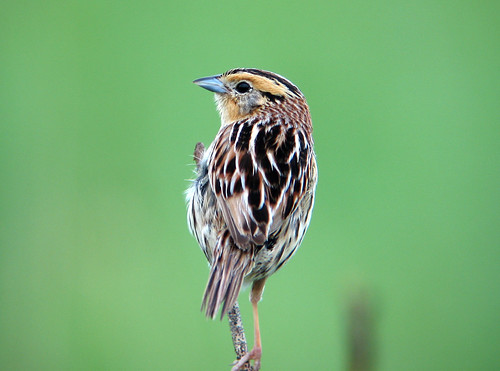Back when I was in my 20s, I was usually the first in birding groups to hear a Le Conte’s Sparrow or Blackpoll Warbler. The first year I didn’t hear any Le Conte’s Sparrows at my mother-in-law’s place in Port Wing, I thought the local population had disappeared, not that my ability to hear them had. I realized it was my own hearing only gradually. Hearing loss must work rather the way cataracts do—virtually everyone I know who’s had cataract surgery on one eye was shocked at how suddenly bright and colorful everything was through that eye, and how dingy and brownish everything was through the other eye—they’d never noticed the gradual darkening as the cataracts grew. I was equally surprised when first wearing my hearing aids that suddenly robins sounded much better again. I’d never lost the ability to hear them, but without realizing it, I had lost the high-frequency overtones that give robin songs their brilliance.
The vast majority of people who get hearing aids most urgently need to hear human voices more clearly, so hearing aids are usually programmed to enhance the middle frequencies. Mine certainly help with that, but they were specially programmed by my audiologist to bring out the highest frequency sounds. High quality hearing aids are great at helping us hear against background noise—with my hearing aids, I can hear birds against a noisy wind or wave background even better than when I was in my 20s.
So I love my hearing aids, but they’re not perfect. I can’t hear a Le Conte’s Sparrow anymore even with them, unless I'm so close that I could see it with my bare eyes anyway. But they definitely improve my ability to hear Cedar Waxwings, Golden-crowned Kinglets, Brown Creepers, and Blackburnian, Cape May, and Blackpoll Warblers.
When I’m recording birds, wearing headphones with my powered Sennheiser shotgun microphones, I can hear even distant Le Conte’s Sparrows, but lugging that equipment on top of my camera and binoculars is more than I want to deal with when I’m not specifically wanting to record birds, especially because I need to point a shotgun mic almost directly to where a bird is to hear it at all.
 |
| Here I am wearing my hearing aids (you can see the one tucked behind my ear) with my SongFinder headphones around my neck. Wearing both like this maximizes the number of birds I can hear well. |
This wonderful invention is expensive—it cost $750 plus shipping and tax—but that’s still an order of magnitude less than my hearing aids cost while bringing more birds to me than my hearing aids can.
I’ve written about this for my podcast and blog, and in an article for the American Birding Association’s magazine. So this “woman of a certain age” often hears from people who want advice about hearing birds better. This week, I got an email from a birder in Virginia that made me really sad. It read:
Your article on digital hearing aids intrigued me. I did some research and learned that the Song Finder device is no longer being sold. Do you have any information about similar products either on the market or soon to be? I am frustrated enough to give up birding.I went to the SongFinder website, appropriately at the URL hearbirdsagain.com, and sure enough—they were discontinued back in October.
Tragically, the SongFinder was designed for an extremely tiny niche market. There are plenty of birders and nature aficionados who have lost their upper-range hearing, of course, but the number of them willing to admit to a hearing loss and to wear headphones in public to hear warblers and sparrows, or insects or frogs, is pretty tiny. So I’m not surprised, but very disappointed, that more birders with hearing loss won’t get to experience high-frequency birds, insects, hearing frogs the way I can. This invention was sheer genius, and I feel really sad that developing such a wonderful tool couldn't be sustainably profitable.


